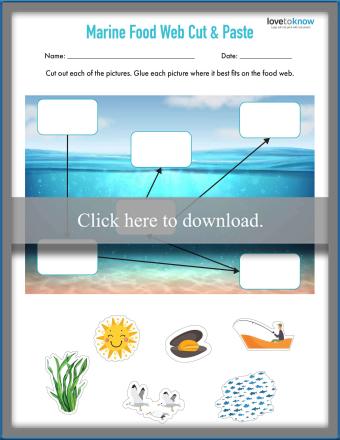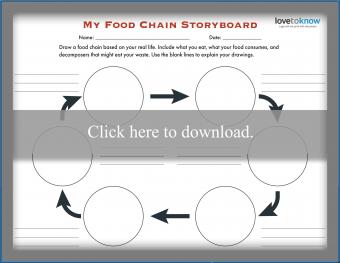
Food chain instruction is a staple of kids' biology lessons. You can use food chain worksheets and lessons to teach elementary and middle grades students about how plants, animals, insects, and the environment depend on each other. Click on the image of the worksheet you want to try, then download or print. You can use the Adobe guide to help with any problems.
Food Chain Order Worksheet
Kids can test their knowledge of a simple food chain by numbering each resource, plant, or animal in the correct order for this food chain worksheet with answer key. Students are asked to number the items in order from one to five, with one showing where the energy starts and each number going around the circle consecutively to show the chain of events.

Using This Worksheet
Kids as young as age five can work with an adult to complete the worksheet. You can extend the activity by asking kids to draw food webs featuring different plants and animals. The worksheet helps kids learn:
- The food chain starts with producers, such as plants.
- Consumers eat the producers or other consumers.
- Decomposers take care of the consumers after they die, fertilizing the land.
- The process starts again.
Marine Food Web Cut and Paste Worksheet
Upper elementary kids in grades three, four, or five who have progressed from basic food chains to more complex food webs can complete this marine food web worksheet with answer key. Students have to cut out six images of food web elements and paste them in the correct spot on the blank food web. In this food web, the arrows point to what a plant or animal is consumed by.

Using This Worksheet
You can extend the activity by asking kids to find, cut, and glue images of other marine animals and plants to the worksheet, then draw arrows showing their food chains. This worksheet helps kids learn:
- Marine food chains include things in the water and outside the water.
- Food chains are more complex than simple straight lines or circles.
- Humans can be part of marine and terrestrial food chains.
My Food Chain Storyboard Worksheet
Kids in upper elementary school and middle school can explore more complex ideas about food chains, like where they fit in a food chain in their real lives. This open-ended worksheet asks students to create a basic circular food chain based on their actual life. Kids can illustrate what they consume, where it comes from, what their food consumes, and so on.

Using This Worksheet
Younger kids can use the storyboard worksheet with some help from an adult. To make the activity easier, fill in one or two of the empty squares and ask kids to fill in the rest. This worksheet helps kids learn:
- Each person is part of a food chain.
- Humans can provide food for other living things.
- Your food comes from somewhere and may have once been alive.
Fun Food Chain Lesson Ideas
Kids learn best from modeling and hands-on activities. Make the most of food chain lessons by combining basic instruction with fun extension activities.
Put on a Puppet Show
Use finger puppets, hand puppets, or stick puppets and other items like fake flowers or gummy worms to put on a puppet show featuring one food chain. You can create the puppet show and present it or enlist the help of students to create the puppets, props, and script.
Watch the Garden
Kids who have a lot of patience can spend some quiet time sitting and watching a garden or outdoor location like a tree. Together, you can observe different insects, plants, and animals and discuss who's eating what. If you can't spend that much time outside, you could set up a trail cam and watch the footage.
Follow the Food From Farm to Store
If you live in a rural area or near a rural area, check with local farms to see if they offer tours for kids. Let kids write, draw, video tape, or take pictures of each part of the food chain, then review what they learned when you get home. You can follow the food chain by exploring where it starts on the farm and visiting the stores, farm stands, or farmer's markets where the food is delivered, then visiting a waste management facility.
Key Food Chain Vocabulary
Each part of a food chain performs a certain role. Some organisms do not always retain the same role in the food cycle. For example, a grizzly bear can shift from being a primary consumer eating berries to a secondary consumer eating fish to being the top predator. Each food chain is made up of:
- Primary Producers: These are plants and other basic organisms. They gain their energy from the sun via a process known as photosynthesis or from chemosynthetic bacteria, which is found in hydrothermic vents in the oceans. Primary producers are also called autotrophs.
- Primary Consumers: Next are the organisms that eat the primary producers. These are also called herbivores. These are animals that feed only on autotrophs, but are usually eaten by other animals (carnivores).
- Secondary Consumers: This level is made up of organisms that eat the primary consumers. This might be a snake that feeds on a rabbit.
- Tertiary Consumers: These organisms eat the secondary consumers, such as a snake. This is simply a larger predator, but still feeds on another complex organism. An example might be a hawk that eats a fish that ate the worm that fed on the bacteria in the pond.
- Quaternary Consumers: These eat the tertiary consumers. For example, a wolf captures an injured hawk and eats it.
- Top Predator: A top predator is the highest in a given food chain. Some examples might be a mountain lion or a grizzly bear. These animals are large, fast, strong, or all of the above. They do not have natural predators.
- Decomposers: When an organism dies, it is further broken down by worms, crabs and vultures and then by the decomposers of bacteria and fungi.
Key Food Chain Lessons
There are some key concepts you need to make sure your students understand about food chains. Make sure you incorporate these into food chain lessons.
- The concept of a food chain is a big concept that states that organisms gain energy from somewhere.
- The concept is then broken down in the stages of gaining energy or giving energy back to the earth.
- Food chains are constantly changing and in motion.
- There is a cycle to each ecosystem and specific organisms that live within that ecosystem. The food chain in a desert is different from the food chain in the ocean.
Have Fun With Food
Learning about food chains can be fun when you incorporate different ecosystems, plants, animals, and decomposers. Connecting kids to food chains can also make lessons more exciting. Once kids have mastered the basics of food chains and food webs, they can move onto food chain worksheets for high school that feature things like food pyramids and extensive vocabulary lessons.







